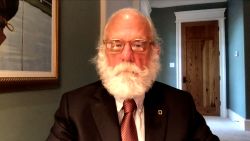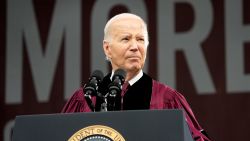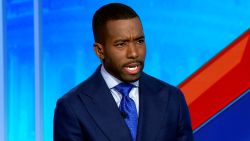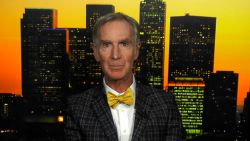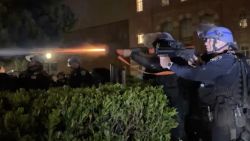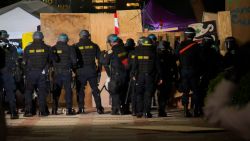President Donald Trump’s threat of violent police retaliation and military intervention in Minnesota on Friday thrust him squarely into a familiar position as racial instigator and defender of law enforcement.
The continuing protests in Minneapolis and unrest brewing in other American cities posed another test of leadership for a President who has spent the last several months unsteadily confronting a global pandemic. The parallel crises have left the nation, and particularly its communities of color, reeling and looking for answers.
After an overnight tweet laden with racist overtones, Trump spent Friday attempting to strike a more measured tone and denying he was evoking a phrase with ties to brutal civil rights-era police tactics when he wrote, “when the looting starts, the shooting starts.”
Speaking during a roundtable with retail and restaurant executives Friday afternoon, Trump disclosed that he’d spoken with the family of George Floyd, a black man who died after a white police officer pinned him to the street by his neck as he gasped for breath. Trump said he wanted “to express our nation’s deepest condolences and most heartfelt sympathies.”
“We are determined that justice be served,” Trump said, announcing that he’d ordered the Justice Department to expedite a federal investigation into the matter.
Addressing protests that turned violent – and which he earlier said on Twitter could force him to deploy the military to quell – Trump encouraged peace.
“The looters should not be allowed to drown out the voices of so many peaceful protesters,” he said.
And he insisted that most of the country’s police officers were performing admirable work, and that the one who knelt on Floyd’s neck – who was arrested and charged with Floyd’s murder on Friday – was an aberration.
“This was a terrible insult to police and policemen,” the President said of the officer’s behavior.
Trump – whose actions on race and policing have more traditionally fallen in the “blue lives matter” camp than the black ones – chose earlier in the day to forgo an opportunity to address the situation on Friday afternoon during an appearance in the Rose Garden.
Aides had planned for Trump to address the violence during that appearance, which was originally billed as a news conference. But after delivering a statement on China and announcing he was ending the US relationship with the World Health Organization, he walked away without answering questions.
While he decried China for its actions in concealing the origins of coronavirus, he did not mention the mounting US death toll, which ticked above 100,000 this week.
That ceded, for a time, the leadership space to his election year rival Joe Biden, who had addressed the Minneapolis situation an hour before Trump emerged. Speaking from his Delaware home, Biden said he’d talked with Floyd’s family.
Trump’s aides had debated having the President deliver a statement on the situation, but those plans were scrapped by the time he stepped from the Oval Office. Several advisers, worried about the optics of saying nothing at all, said he should address the matter because Biden had already spoken on it.
But those views were apparently overruled by officials who encouraged Trump to forgo questions, which might overshadow his announcements on China and the WHO. Other aides were also concerned Trump might face a barrage of questions over his late-night tweets about looting.
Even as he works to build support among African American voters, Trump has shown he’s not abandoning the law-and-order themes that, along with a willingness to exploit white grievances, helped propel him to the White House in 2016.
His overnight tweets, which appeared while images of fires and destruction aired on cable news late into the evening on Thursday, were slapped with a warning by Twitter for violating its rules against glorifying violence.
Trump later sought to explain the messages as statements, not threats, but not before the governor of Minnesota deemed them “not helpful” and Biden declared them a call to violence.
In them, Trump seemed to imply protesters could be shot and the US military could become involved if violence continued in the city, which has been gripped with unrest after disturbing video emerged of Floyd’s arrest.
“These THUGS are dishonoring the memory of George Floyd, and I won’t let that happen,” Trump wrote on his personal account. “Just spoke to Governor Tim Walz and told him that the Military is with him all the way. Any difficulty and we will assume control but, when the looting starts, the shooting starts. Thank you!” The White House, defying Twitter’s objection, later tweeted the same remark on its official account.
The message marked a distinct return to form for the President, whose initial response to the situation – calling the video “shocking” and demanding justice – was itself markedly different from how he had approached instances of police brutality in the past.
Later Friday, Trump sought to explain his message, writing in a new tweet, “I don’t want this to happen, and that’s what the expression put out last night means.”
“It was spoken as a fact, not as a statement,” he went on. “It’s very simple, nobody should have any problem with this other than the haters, and those looking to cause trouble on social media. Honor the memory of George Floyd!”
The language in his original tweet seemed to harken back to tough-on-crime heavy handedness that is now under scrutiny for disproportionately affecting men of color.
“I’ve let the word filter down that when the looting starts, the shooting starts,” said Miami Police Chief Walter Headley in 1967 as he announced a campaign against crime that included using dogs, guns and a “stop and frisk” policy.
“We don’t mind being accused of police brutality,” Headley said in the news conference, according to an article from the period in The New York Times.
Trump denied knowledge of the term’s origin during his roundtable with executives.
“I wouldn’t know a thing like that,” he said. “When there’s looting, people get shot and they die.”
In the decades since Headley was touting them, tactics like “stop and frisk” have been reexamined for their implicit racial bias. Using tactics like aggressive hold positions on arrestees have been scrutinized for their safety after a number of deaths.
But Trump has spoken out rarely on the issue, and during the first three years of his presidency was more likely to side with law enforcement than with the minority communities that have protested their tactics.
He called for a return of “stop and frisk” in 2018, telling police chiefs at a convention he was instructing his Justice Department to work toward reinstating it in Chicago, where its use had been curtailed.
“Got to be properly applied, but stop and frisk works,” he said then.
At other moments, Trump has appeared to endorse tactics by police that might harm people in custody, including failing to protect an arrestee’s head when putting them into a squad car.
“When you guys put somebody in the car and you’re protecting their head, you know, the way you put their hand over?” Trump said in a speech to law enforcement officers in 2017, mimicking the action. “I said, you can take the hand away, OK?”
He spoke out forcefully against NFL quarterback Colin Kaepernick, whose kneeling protest during the playing of the National Anthem was meant to shine a spotlight on racial injustice and harsh police tactics. Trump’s vice president, Mike Pence, even stormed out of an Indianapolis Colts game when some players kneeled during the anthem.
Trump declined to comment on certain cases of white-on-black killing, including the shooting death of Stephon Clark in California at the hands of police. He hasn’t commented on the 2014 killing of Eric Garner, whose last words – “I can’t breathe” – came as police placed him in a chokehold.
Instead, Trump has been more likely to mock that phrase, which has been used by Black Lives Matter protesters ever since. In 2016, he made fun of Mitt Romney by bringing his hands to his neck and shouting “I can’t breathe” to illustrate Romney “choking” in the 2012 presidential election.
Before he was elected, Trump had a long history of stoking racial controversies, including his attempts to undermine President Barack Obama’s legitimacy as president by claiming he was born outside the United States.
In 1989, he sided with police in the case of the Central Park Five, a group of young men of color who were wrongfully convicted of raping a jogger.
Asked last year by a reporter if he would apologize for his actions surrounding the case – he took out full-page newspaper ads calling for the death penalty that read: “Bring Back The Death Penalty. Bring Back Our Police!” – Trump instead asked why the topic was relevant.
“Why do you bring that question up now? It’s an interesting time to bring it up. You have people on both sides of that. They admitted their guilt,” he said.
In cases of domestic unrest, Trump has sometimes sided with protesters. When violent white nationalists marched in Charlottesville, Virginia, in 2017, Trump deemed there to be fine people on “both sides” of the conflict. And he sided with protesters in Michigan earlier this month, some of whom arrived armed at the state capitol in Lansing to contest ongoing stay-at-home orders due to coronavirus.
More from CNN Politics
The history of either silence or reflexive support for police seemed to be shifting this month when Trump weighed in on two new cases of white-on-black violence in Georgia and Minnesota.
He called the death of Ahmaud Arbery, who was shot by a white man while jogging in February, a “heartbreaking thing.” His Justice Department is investigating the killing as a federal hate crime, though Trump has held out the possibility that “something that we didn’t see on tape” could explain the killing.
Trump was briefed on the Floyd case Thursday afternoon by Attorney General William Barr and was “very upset” when he saw the video, according to his press secretary. Many of Trump’s allies in conservative media echoed Trump’s call for justice in the case.
The shift in tone coincided with Trump’s campaign effort to peel off Black voters from Democrats, hoping to convince them Trump is a better candidate than Biden, who caused controversy last week when he told a radio host that African-American Trump supporters “ain’t black.”
Biden’s own history on race and policing is fraught; he supported crime bills in the 1980s and 1990s that led to a spike in incarcerated black men. But he maintains an overwhelming lead among black voters and has frequently backed civil rights legislation.
This story has been updated Friday with additional developments.
CNN’s Kaitlan Collins, Jim Acosta and Sarah Westwood contributed to this report.





